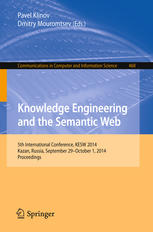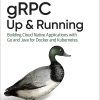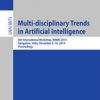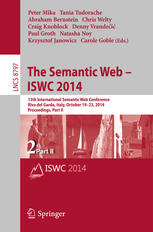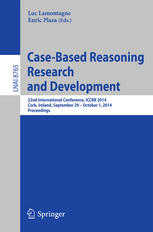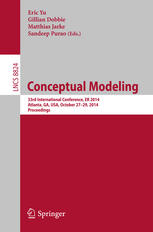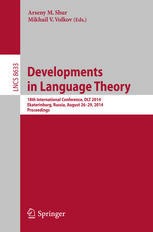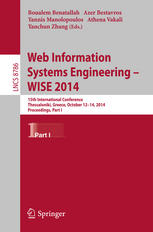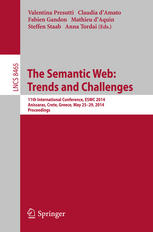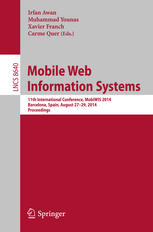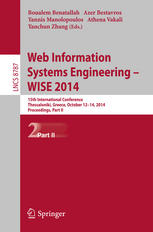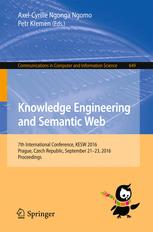Knowledge Engineering and the Semantic Web 5th International Conference KESW 2014 Kazan Russia September 29 October 1 2014 Proceedings 1st Edition by Pavel Klinov, Dmitry Mouromtsev ISBN 3319117165 9783319117164
$50.00 Original price was: $50.00.$25.00Current price is: $25.00.
Knowledge Engineering and the Semantic Web 5th International Conference KESW 2014 Kazan Russia September 29 October 1 2014 Proceedings 1st Edition by Pavel Klinov, Dmitry Mouromtsev – Ebook PDF Instant Download/Delivery: 3319117165, 9783319117164
Full download Knowledge Engineering and the Semantic Web 5th International Conference KESW 2014 Kazan Russia September 29 October 1 2014 Proceedings 1st Edition after payment
Product details:
ISBN 10: 3319117165
ISBN 13: 9783319117164
Author: Pavel Klinov, Dmitry Mouromtsev
This book constitutes the refereed proceedings of the 5th Conference on Knowledge Engineering and the Semantic Web, KESW 2014, held in Kazan, Russia, in September/October 2014. The 18 revised full papers presented together with 4 short system descriptions were carefully reviewed and selected from 44 submissions. The papers address research issues related to semantic web, linked data, ontologies, natural language processing, knowledge representation.
Knowledge Engineering and the Semantic Web 5th International Conference KESW 2014 Kazan Russia September 29 October 1 2014 Proceedings 1st Table of contents:
1 Introduction
2 Related Work
2.1 Construction of Text Corpuses for Machine Learning Purposes
2.2 Accounting for Historical Development of Domain Lexicon
3 Statistical Properties of the Texts
4 The Text Clustering Approach
5 Conclusion
References
Domain Categorization of Open Educational Resources Based on Linked Data
1 Introduction
2 Theoretical Background
2.1 Knowledge Organization Systems
2.2 Current Techniques to Categorization in Subject Areas
2.3 Use of Spreading Activation to Traverse a Graph
3 Process for Domain Categorization of OER
3.1 Data Processing
3.2 Categorization Layer
4 Proof of Concept
4.1 Data Processing
4.2 Categorization According a Sub-discipline
5 Conclusion
References
Cloud Sensor Ontology and Linked Data to Support Autonomicity in Cloud Application Platforms
1 Introduction and Motivation
2 Background
2.1 Cloud Application Platforms as Sensor Networks
2.2 Self-adaptation Framework for CAPs
3 Related Work
4 Cloud Sensor Ontology (CSO)
4.1 Structure of the CSO
4.2 Example: The Role of the CSO in a Sample Adaptation Loop
5 Next Steps:Linked Data
6 Summary and Conclusions
References
Construction of Personalized Information Services for Researchers
1 Introduction
2 Related Work
3 User Information Needs
3.1 Basic Model of User Information Needs
3.2 Query Life Cycle
3.3 Model of the Information Environment for the Personalized Service
4 Architecture of the Personalized Service and the Used Ontologies
5 Query Management Module
6 Query Preparation
6.1 SPARQL Query Preparation
6.2 News Feeds (RSS)
6.3 HTML+RDFa
6.4 HTML Documents
7 Data Collection Using the Query Management Module
7.1 Data Collection from SPARQL Endpoints
7.2 Data Collection from RSS Feeds, HTML+RDFa Documents and HTML
8 Design Patterns for Data Collection
9 Preliminary Evaluation
10 Conclusion and Future Work
References
Towards Building Wordnet for the Tatar Language: A Semantic Model of the Verb System
1 Introduction
2 Challenges
2.1 Morphological Complexity of the Tatar Language
2.2 Available Resources in Tatar Language
3 Methodology
3.1 General Principles of Wordnet Development
3.2 Language Specific Features of the Tatar Verbs in a Wordnet-Like Thesaurus
4 Preliminary Evaluation
5 Conclusion
References
Access Control, Triggers and Versioning over SPARQL Endpoint
1 Introduction
2 Related Work
3 Motivation
4 Implementation
5 Benchmark
6 Conclusions
References
Return on Investment in Linking Content to CRM by Applying the Linked Data Stack
1 Introduction
2 CRM Use Case Scenario
2.1 The Problems Faced by the CRM User
2.2 Required Data Sets
2.3 Average Time Required to Fulfill the Tasks without LD
3 Adoption of the Linked Data Lifecycle
3.1 Ontos Linked Data Information Workbench
3.2 Applying OntosLDIW to the CRM Use Case
3.3 Project Status and the Lessons Learned
4 ROI Validation
5 Related Work
6 Conclusion and Further Work
References
Creating Cognitive Frames Based on Ontology Design Patterns for Ontology Visualization
1 Introduction
2 Background
3 Considering Ontology Design Pattern as Viewpoints
4 Creating CDP-Based Cognitive Frames
4.1 Creating the Content of Cognitive Frames
4.2 Building Images of Cognitive Frames
5 Evaluation of the Proposed Visualization Method
6 Conclusions and Future Work
References
OntoMathPRO Ontology:A Linked Data Hub for Mathematics
1 Introduction
1.1 Motivation
1.2 Related Work
2 OntoMathPRO Structure
2.1 Modeling Principles
2.2 Concepts
2.3 Relations
2.4 Links to Other Datasets
3 Applications
3.1 Information Extraction
3.2 Concept-Based Formula Search
3.3 Education
4 Conclusion
References
Semantic Analysis and Prediction of Various Risks of Diabetic Patients
1 Introduction
2 Background
3 Methodology
4 Implementation
5 Results and Discussions
6 Conclusion and Future Work
References
Interaction History Based Answer Formulation for Question Answering
1 Introduction
2 Related Work
3 Interaction History Based Answer Formulation (IHAF)
3.1 Basic Utilities Incorporated
3.2 Building the User Model
3.3 Answer Formulation
4 Results
5 Discussion
6 Conclusion and Future Work
References
Automatic Term Extraction for Sentiment Classification of Dynamically Updated Text Collections into
1 Introduction
2 Overview of Term Weighting Schemes
3 Corpora Characteristics
3.1 Short Text Corpus
3.2 News Corpus
4 Preparation for the Experiment
4.1 Preparation Texts for the Classifier
4.2 The Classifier
4.3 Quality Assessment
5 Results of the Experiment
6 Conclusion
References
Distributed Knowledge Acquisition Control with Use of the Intelligent Program Environment of the AT-
1 Introduction
2 General Characteristics of the Combined Method for Knowledge Acquisition
3 Applications of Distributed Knowledge Acquisition
4 Implementation of the Typical Design Procedure “Knowledge Acquisition from Database”
5 Conclusion
References
A Feature Selection Approach for Anchor Evaluation in Ontology Mapping
1 Introduction
2 Mapping with Partial Alignments
2.1 Anchor Filtering
3 Proposed Approach
3.1 Filtering Using Feature Selection
4 Evaluation
4.1 Syntactic Similarity
4.2 Structural Similarity
4.3 Semantic Similarity
5 Conclusion and Future Research
References
Linked-Data Integration for Workflow-Based Computational Experiments
1 Motivation
2 Background
3 Data Import with Generic Image Abstraction
4 Implementation
5 Use Case
6 Discussion and Conclusion
References
Ontology for Resource Self-organisation in Cyber-Physical-Social Systems
1 Introduction
2 Upper Ontology
3 Resource Self-organization
3.1 Multi-level Self-organization
3.2 Ontology for Self-organization of Resource Agents
4 Case Study
5 Conclusion
References
Words Worth Attention: Predicting Words of the Week on the Russian Wiktionary
1 Introduction
2 Related Work
3 The Russian Wiktionary
4 The Model
4.1 Features
4.2 Discretization
5 The Dataset
6 Evaluation
6.1 Classifiers
6.2 Performance on the Featured Class
6.3 Overall Performance
7 Discussion
7.1 Quality of the Training Set
7.2 Does Size Matter?
7.3 “It Was on the Front Page Before It Was Featured”
8 Conclusion
References
Deriving of Thematic Facts from Unstructured Texts and Background Knowledge
1 Introduction
2 Related Work
3 The Approach and Basic Models
3.1 Using Ontologies for Thematic Fact Extraction
3.2 Deriving Facts Based on the Basic Knowledge and Facts Extracted in the Document Analysis Process
4 Algorithms
5 Implementation
6 Preliminary Experimental Results
7 Conclusion and Further Work
References
System Description Papers
A Collaborative Development of Ontology-Based Knowledge Bases
1 Introduction
2 Requirements for KB Editors Supporting Collaborative KB Building
3 Related Work
4 KB Editor’s Model
4.1 KB Version Control
4.2 User’s Roles and Permissions
4.3 Integration of Discussions to the Development Process
4.4 Changes and Notifications Controllers
5 KB Editor’s Functionality and Its Implementation
6 Conclusion
References
A Tool to Convert Linked Data of E-Learning System to the SCORM Standard
1 Introduction
1.1 The Ontology-Based E-Learning System
1.2 The SCORM Standard
1.3 Problem Description
2 The Ontology Model
3 Implementation
3.1 Overall Architecture
3.2 Conversion Methods
3.3 Generation of SCORM Content
3.4 Integration
4 Conclusion
References
OntoFast: Construct Ontology Rapidly
1 Introduction
2 Use
3 Results and Discussion
References
Mathematical Content Semantic Markup Methods and Open Scientific E-Journals Management Systems
1 Introduction
2 Semantic Markup
3 Scientific E-Journal Management Systems
4 Using Services of Semantic Markup in E-Journal Management Systems
People also search for Knowledge Engineering and the Semantic Web 5th International Conference KESW 2014 Kazan Russia September 29 October 1 2014 Proceedings 1st:
knowledge engineering and the semantic web
semantic engineering
semantic web vs knowledge graph
knowledge engineering examples
semantic knowledge definition
Tags:
Pavel Klinov,Dmitry Mouromtsev,Engineering,Semantic web,International Conference,Kazan,Russia
You may also like…
Computers - Computer Science
Computers - Computer Science
Computers - Networking
Computers - Computer Science
Developments in Language Theory 1st Edition by Arseny Shur, Mikhail Volkov ISBN 3319096982 97
Computers - Computer Science
Computers - Computer Science


